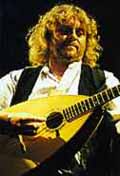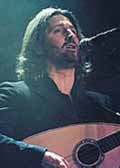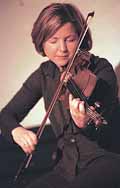 |
||
The Living Tradition
|
|
|||
| The Easy Club - The Sultans of Jings* by Jack Evans |
|
|||
|
{graphic} |
||||
|
*Brian
McNeill named them The Sultans of Jings! George Orwell imagined that some pretty nasty things would be happening in 1984. Luckily he was a bit wide of the mark - but he was right enough about it being an unusual year, one way and another. Because in 1984 a Scottish band released an album which was, to say the least, strange. The band had a weird name - not the regulation Scots or Gaelic type of moniker. The album's artwork looked like the menu from a 1950's American diner. And as for the music on that album - well, I'm biased because I played on it, but it's fair to say that the music sounded unlike anything else being done in Scotland, or anywhere else in the UK. Some might say that this still holds true today. The Easy Club's 'Scottish Rhythm n' Swing' style of playing traditional music was not especially modern - it was actually quite a retro sound, drawing on many recent musical traditions, American as well as Scottish, and forcing them together into a startling type of fusion - which did sound new. People who heard it were often initially a bit shocked, then intrigued - then (usually) they loved it. A few Scottish musicians (perhaps fearing that they might have to play in that style if it caught on) disliked it. But few could deny that The Easy Club's music was the hottest thing in town. The Easy Club appeared to have sprung from nowhere, but of course it wasn't really like that. Years of earnest discussions in smoky pubs, downing pints without number, had to be endured first. But a key turning point in the gestation of The Easy Club had occurred a couple of years prior to that first album coming out. In 1982, Jock Tamson's Bairns had released their second album, The Lasses' Fashion. Tony Engle put it out on Topic, which at the time was the most prestigious label in Britain (Greentrax had yet to be invented). Though the Bairns were not a full-time band, their music was setting some new benchmarks for quality which the pros of the day were taking serious notice of. Among the many superb tracks on this album was a pair of tunes which I felt opened up a new area of exploration for bands playing Scots music. I asked the other Bairns what they thought about this track going last on the album - as a kind of signpost, pointing the way forward. Donald, Willie and his Dog/Peter MacKinnon of Skeabost, with Rod Paterson's brilliant guitar arrangement moving from languid and plangent to powerful, choppy cross-rhythms, duly became the last track. This arrangement, to my ears anyway, seemed to be saying that the way forward for Scottish music was going to be through rhythm. Jock Tamson's Bairns' reputation was at an all time high, but the demands of young families were making it difficult for some of the band to give it as much time as before. Those of us not burdened by sprogs found ourselves with time on our hands, and used up some of it by playing many excellent sessions around Edinburgh with newly arrived cittern player and bad boy of the bodhran world, Jim Sutherland. Jim's thunderous drumming infuriated those who thought that the tune was more important than the accompaniment. As we were keen to turn this widely held assumption on its head, we rather liked Jim's crash-test punishment of Dave Gormlie's superb tuneable bodhrans. Rod Paterson, Norman Chalmers, Jim Sutherland, and myself played the odd gig under the classy name of The Bogey Brothers (the name The Easy Club came along later, inspired by the poet Allan Ramsay's Edinburgh drinking club). We experimented with rhythmic ideas, tried to bring out the internal rhythms of the tunes, and generally made a decent enough noise - but it wasn't that radically different from what you might have heard elsewhere at that time. The Easy Club's uniquely swingy take on Scottish music came about in a sudden, and slightly spooky, fashion. Jim Sutherland shared a seedy flat in Buccleuch Street, Edinburgh, with Gary Peterson, of Hom Bru - a wonderful high octane Shetland band. This flat, where we used to practice quite regularly, boasted a mummified leg of reestit mutton hanging on the kitchen door, and the biggest collection of mouldy milk bottles in town. One afternoon, Jim began playing a reel in A on the cittern, pushing the offbeat hard as he always did. Rod, who had learned some jazzy guitar moves from playing with the late Jimmy Elliot (a great old jazz player and frequenter of Sandy Bell's), began backing up the tune with some swingy barre chords in that Jimmy Elliot/Peerie Willie kind of style. The combination of swung rhythm guitar with Jim's powerful offbeat emphasis caused the tune to burst into life like a Roman candle. Norman and I joined in with a similar feel, and the music was suddenly rocking like we'd never heard it before. A bit shaken by this experience, we partook of some weak tea, and discussed what had happened. We had all heard jazz guitar accompaniments to tunes many times before, but never felt that it really worked - mainly because the tune was still being played in a 'straight' manner. Start swinging the tune too, though, as Jim was doing, and the combination really gelled. We knew straight away that this was going to be the signature style of The Easy Club. Soon after that particular epiphany on Buccleuch Street, I went back to the flat to find Jim where he could often be found - sitting in front of a music stand, cittern in hand, pencil at the ready, writing tunes. "Listen to this", he said. "I've written a tune for the band, with syncopations and all that." I sat down to listen while Jim played the just-finished tune. It was 'The Easy Club Reel'. 'The Easy Club Reel', written with our new style in mind, quickly became our signature tune, and our set was soon filling up with swingy instrumentals. Songs were still a problem though, as most couldn't take the swing treatment. We knew that we needed a wider range of rhythms to suit different songs. For fast numbers, Jim's bodhran beater of choice was a hammer handle, but he had already invented the brush stick - a pair of drum brushes spliced on to a bodhran beater, which allowed him to play swingy bodhran with slower numbers and songs. With yet more grooves and rhythms demanding new skills and sounds, we went off to Gordon Simpson's music shop and bought what must have been the first ever set of congas to be used in Scottish music. The band urgently needed a demo to help us get some gigs, so we recorded six tracks at the newly opened Pier House Studio in Granton. This cassette had some great stuff on it and got us a lot of attention, but it was still only a prototype of the full-blown swing style that we developed later - after some fairly drastic changes to our instrumentation. Before that would happen, though, the first incarnation of The Easy Club folded. Insufficient gigs, plus outside commitments and pressures, caused us to cease operating as a band. It seemed that The Easy Club was not going to survive the economic tribulations of the time. But in the months that followed, Jim Sutherland and I continued to play sessions, developing ideas, and learning new tunes. Joining us in this was a new fiddler in town - John Martin, ex of Ossian. Jim and I both owned citterns made by Stefan Sobell, and we loved his instruments. One evening at a Bairns gig in Newcastle, Stefan appeared with two guitars he'd made. Based on the design of an old 1930's Martin, these instruments had carved tops like a jazz guitar, but round soundholes like a folk guitar. As The Easy Club's music started to come together, I realised my old flat top guitar wasn't cutting the mustard, and that Stefan's new guitar could be just what I needed. I asked him if he could make one with a very loud treble side, even at the expense of some bass. He explained that most factory guitars were made too bassy anyway so they'd sound good in the shop, and that he had a piece of spruce with grain so close that it would be perfect for the guitar I was after. It was. We ended up getting a guitar and a new spruce-top cittern from Stefan, whose mattress now bulged with Scottish tenners. I bought every chord book I could find, and sat down to change my playing style from the bass-heavy jugband stomp that I'd used with the Bairns, into something a bit more sophisticated - and swingy. The style I was working on was dictated to some degree by the sound that the Sobell guitar made, and differed from what's sometimes referred to as the Shetland style of rhythm guitar, which has a very mobile bass line. I was happy to keep the bass simple, often just pedalling on the open A or E string, while the treble voicings of the chords moved up and down, adding melodic and percussive licks to the arrangement. This melodic chording style was similar to the way electric guitarists play, with riffy chords and shapes that you can slide around, high up the neck. I was able to try out these new changes during the sessions we played in various pubs around Edinburgh (Sandy Bell's having deteriorated badly during this time; after the death of its manager, Jimmy Cairney, nobody really played there any more). The combination of cittern and fiddle with the new-style guitar was working better than anything we'd done hitherto, coming closer to that earthy Venuti/Lang sound we loved so much. It convinced us that we should re-open the files on The Easy Club. I've often been asked how it was that The Easy Club (Mk II) emerged with a changed line-up - John Martin in place of Norman Chalmers. This was basically down to the way that the music had continued to develop during the band's period of non-existence, a process in which John's fiddle playing had become a crucial part. John Martin was a much more experienced gigging musician than any of us. He had already been everywhere twice, thrived on touring, played fantastically, could handle Jim's most tortuous tunes, turned up on time, and didn't bump into the furniture. We quickly realised how lucky we were to have a musician of his quality committed to the band. Plus John owned a Guild acoustic bass. And a phono-fiddle. After a lot more work getting songs together, improving our trademark swing, learning how to play the Guild bass and numerous other tasks, we felt ready to record an album. A first album often puts bands under fierce new pressures, and we were no exception. At one point we found it impossible to carry on, and recording ground to a halt. Jim, whose only prior recording experience was with Thurso band Mirk, wanted to beef up tracks with busy bodhran overdubs, which would have obliterated my carefully honed guitar parts utterly. Mixing, too, had turned into a nightmare. During this impasse, Rod and I sat in Mather's Bar one afternoon and seriously discussed sacking Jim from The Easy Club. We can laugh about it now, but at the time the only alternative appeared to be the end of the band. Eventually everything got resolved though, due in no small part to Pier House engineer Peter Haigh kicking us out of the control room while he mixed tracks, then letting us back in to hear what he'd done - which always sounded much better than the mess we were making. We released the album on our own label (Abbeyhill Music - named after the area of Edinburgh where most of us lived at the time). Reactions were mixed at first. We expected the older folkies to be shocked, but actually many of them liked it. Danny Kyle was an early convert, and Scotsman scribbler Alastair Clark was keen. They recognised the references to a time when folk, jazz, and blues were part of the same alternative music scene - a time which had been good for folk music, and raised its profile with the public. Since then, traditional music (as it now preferred to be called) had attempted to kid on that it was somehow free from the pollution of modern influences. The ones who took against The Easy Club's stuff, strangely, were those few Scottish musicians who believed that only Irish music was worth listening to. This was in marked contrast, it should be noted, to actual Irish musicians, who loved the swing and the unusual tunes. 'The Easy Club Reel', in a slightly less syncopated form, eventually entered the Irish repertoire. It also, in a revised version, become a very popular tune with Scottish pipers. Gradually, The Easy Club's music got through to more and more people. Many approved of the fact that this was new Scottish music, and a new take on traditional material, and that it crackled with life and energy. While within Scotland puzzlement at the band could still be found, outwith Scotland we met with very receptive audiences for what we were up to. What people really liked was that The Easy Club played with a kind of anarchic daring and chutzpah. Between Jim playing tunes on the bodhran, the hot, flashy guitars and ranting cittern, the peerless vocals of Rod, and the smooth yet fiery fiddle of John, The Easy Club on form was positively dangerous. These qualities of chutzpah and joie de vivre proved to be fugitive ones though, hard to maintain intact during the constant touring, the numerous breakdowns (we once attempted to drive our van, Sick Transit Gloria, to Italy with failing brakes), the static fees, and the spiralling costs. With three albums under our belts and over three years of touring behind us, we decided that it might be nice to earn a living, and reluctantly drew a line under the loss-making Easy Club. The music scene in Scotland has changed a lot since 1984, with greater participation, the growth of popularity of Gaelic music, the development of dance, increases in funding, and the emergence of the Celtic music market. A lot more music, for sure - but much of it seems to me rather conservative sounding, as people have learned to play the funding game, feed the market for easily digestible Gaelic music, sound more and more Irish, more and more like everybody else. Audacity seems noticeably absent, but then maybe that's not really what people want to hear any more. The music of The Easy Club is perhaps now just an interesting backwater, warranting no more than a footnote in the history of Scotland's recent musical life. Certainly, the things that we got up to - using new rhythms, new harmonies, producing new kinds of tunes, introducing new instruments, developing new ways of playing instruments - all this seems a world away from some of the preset Celtic moods you hear today. The Easy Club was the product of the unusual group of characters who were involved with it, all of whom (with the notable exception of John Martin, always the most sensible and pragmatic of the lot of us) have carried on doing leftfield things ever since. I became a member of The Cauld Blast Orchestra (with Norman Chalmers) and ended up playing some of the scariest music I've ever heard. Jim has gone on to wilder and wilder things, always with the knobs turned up to eleven. Rod has carried on being Rod, which is in itself a strange and wondrous thing. Bands starting out today may feel that it's wiser to play safe, stick to decent traditional music, don't try to be weird, make a reasonable living, and have a van with working brakes. I agree. But bear in mind that the world is awash with music these days, most of it skilful but ordinary. Just because your music is 'traditional', that doesn't automatically make it worth listening to. If you want to stand out, you need to invest your playing with some special qualities. Where you look for these qualities is entirely your problem. Who said traditional music wasn't experimental? Jack Evans
|
||||
|
Links, further information and recordings: |



